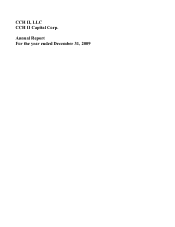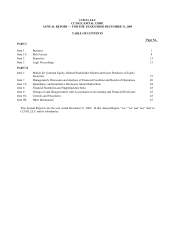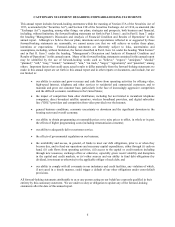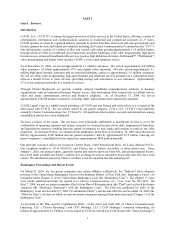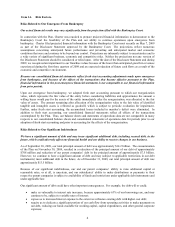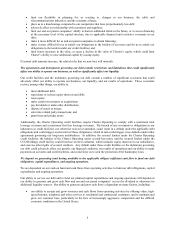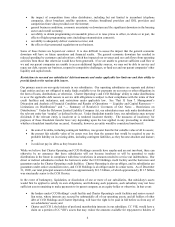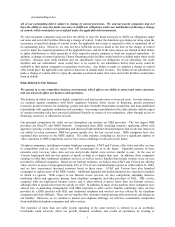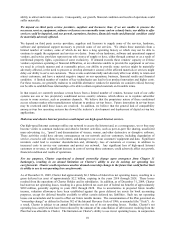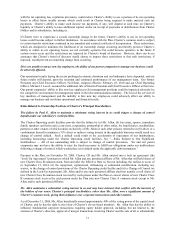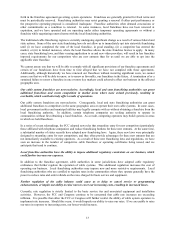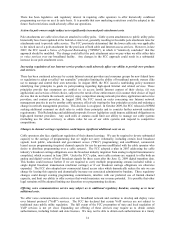Charter 2009 Annual Report Download - page 9
Download and view the complete annual report
Please find page 9 of the 2009 Charter annual report below. You can navigate through the pages in the report by either clicking on the pages listed below, or by using the keyword search tool below to find specific information within the annual report.6
• the impact of competition from other distributors, including but not limited to incumbent telephone
companies, direct broadcast satellite operators, wireless broadband providers and DSL providers and
competition from video provided over the Internet;
• general business conditions, economic uncertainty or downturn and the significant downturn in the housing
sector and overall economy;
• our ability to obtain programming at reasonable prices or to raise prices to offset, in whole or in part, the
effects of higher programming costs (including retransmission consents);
• our ability to adequately deliver customer service; and
• the effects of governmental regulation on our business.
Some of these factors are beyond our control. It is also difficult to assess the impact that the general economic
downturn will have on future operations and financial results. The general economic downturn has resulted in
reduced spending by customers and advertisers, which has impacted our revenues and our cash flows from operating
activities from those that otherwise would have been generated. If we are unable to generate sufficient cash flow or
we and our parent companies are unable to access additional liquidity sources, we may not be able to service and
repay our debt, operate our business, respond to competitive challenges, or fund our and our parent companies’ other
liquidity and capital needs.
Restrictions in our and our subsidiaries' debt instruments and under applicable law limit our and their ability to
provide funds to the various debt issuers.
Our primary assets are our equity interests in our subsidiaries. Our operating subsidiaries are separate and distinct
legal entities and are not obligated to make funds available to us for payments on our notes or other obligations in
the form of loans, distributions, or otherwise. Charter Operating’ s and CCO Holdings’ ability to make distributions
to us or the applicable debt issuers to service debt obligations is subject to their compliance with the terms of their
credit facilities and indentures, and restrictions under applicable law. See “Part II. Item 7. Management’ s
Discussion and Analysis of Financial Condition and Results of Operations — Liquidity and Capital Resources —
Limitations on Distributions” and “— Summary of Restrictive Covenants of Our Notes – Restrictions on
Distributions.” Under the Delaware Limited Liability Company Act, our subsidiaries may only make distributions if
the relevant entity has “surplus” as defined in the act. Under fraudulent transfer laws, our subsidiaries may not pay
dividends if the relevant entity is insolvent or is rendered insolvent thereby. The measures of insolvency for
purposes of these fraudulent transfer laws vary depending upon the law applied in any proceeding to determine
whether a fraudulent transfer has occurred. Generally, however, an entity would be considered insolvent if:
• the sum of its debts, including contingent liabilities, was greater than the fair saleable value of all its assets;
• the present fair saleable value of its assets was less than the amount that would be required to pay its
probable liability on its existing debts, including contingent liabilities, as they become absolute and mature;
or
• it could not pay its debts as they became due.
While we believe that Charter Operating and CCO Holdings currently have surplus and are not insolvent, there can
otherwise be no assurance that these subsidiaries will not become insolvent or will be permitted to make
distributions in the future in compliance with these restrictions in amounts needed to service our indebtedness. Our
direct or indirect subsidiaries include the borrowers under the CCO Holdings credit facility and the borrowers and
guarantors under the Charter Operating credit facilities. Charter Operating is also an obligor, and its subsidiaries are
guarantors under senior second-lien notes, and CCO Holdings is an obligor under its senior notes. As of December
31, 2009, our total principal amount of debt was approximately $13.5 billion, of which approximately $11.7 billion
was structurally senior to the CCH II notes.
In the event of bankruptcy, liquidation, or dissolution of one or more of our subsidiaries, that subsidiary's assets
would first be applied to satisfy its own obligations, and following such payments, such subsidiary may not have
sufficient assets remaining to make payments to its parent company as an equity holder or otherwise. In that event:
• the lenders under CCO Holdings’ credit facility and Charter Operating's credit facilities and senior second-
lien notes, whose interests are secured by substantially all of our operating assets, and all holders of other
debt of CCO Holdings and Charter Operating, will have the right to be paid in full before us from any of
our subsidiaries' assets; and
• Charter and CCH I, the holders of preferred membership interests in our subsidiary, CC VIII, would have a
claim on a portion of CC VIII’ s assets that may reduce the amounts available for repayment to holders of

